Challenges Facing the Use of Remote Sensing Technologies in the Construction Industry: A Review
Abstract
1. Introduction
- The primary goal of categorizing and classifying remote sensing technologies is to categorize and classify the diverse types of remote sensing technologies (such as satellite, airborne, and ground-based systems) employed within the construction industry, developing a comprehensive understanding of diverse remote sensing methodologies through categorization and classification.
- The paper aims to identify and analyze the specific challenges associated with each type of remote sensing technology utilized in construction. By scrutinizing the obstacles and limitations faced by satellite, airborne, and ground-based remote sensing technologies, this review intends to illuminate the practical difficulties construction professionals encounter when integrating these technologies into their projects.
- To propose solutions and future research directions, another objective is to propose potential solutions and suggest future research directions to tackle the challenges identified for each type of remote sensing technology by offering actionable insights to empower construction professionals to enhance the utilization and efficacy of remote sensing technologies in their projects.
2. Background
2.1. Remote Sensing Imaging Mechanism
2.2. Remote Sensing Platform
2.3. Remote Sensing Techniques Applied for Construction Industry
3. Data Collection
3.1. Method of Collection
3.2. Bibliographic Metadata
4. Results
4.1. Overview
4.2. Merits and Limitations of Each Remote Sensing Type
4.3. Challenge of Using Remote Sensing in Construction Management
4.3.1. Temporal Resolutions
4.3.2. Spatial Resolution
4.3.3. Spatiotemporal Resolution
4.3.4. Weather Issues
4.3.5. Atmospheric and Cloud Covering
4.3.6. Shadow Issues
- Obstruction by tall trees: Tall trees can obstruct buildings in the images, leading to incomplete or inaccurate data.
- Sensor observation angle: The observation angle of the sensor can cause anomalies in the shape of buildings, making it challenging to extract accurate information.
- Diversity of building materials and structures: The wide variety of exterior building materials and structures makes it difficult to develop consistent building extraction models.
4.3.7. Logistical and Regulation Issues
4.3.8. Cost Issues
4.3.9. Technical Issues
4.3.10. Standardization Issues
4.3.11. Safety Issues
5. Practical Implications
6. Recommendation for Future Research
7. Conclusions
Funding
Data Availability Statement
Conflicts of Interest
Correction Statement
References
- Zhang, S.; Bogus, S.M.; Lippitt, C.D.; Kamat, V.; Lee, S. Implementing Remote-Sensing Methodologies for Construction Research: An Unoccupied Airborne System Perspective. J. Constr. Eng. Manag. 2022, 148, 03122005. [Google Scholar] [CrossRef]
- Sun, B. Application of satellite remote sensing in the construction and comprehensive management of smart cities. In Advances in Civil Engineering and Environmental Engineering; CRC Press: Boca Raton, FL, USA, 2023. [Google Scholar]
- Moselhi, O.; Bardareh, H.; Zhu, Z. Automated data acquisition in construction with remote sensing technologies. Appl. Sci. 2020, 10, 2846. [Google Scholar] [CrossRef]
- Kushwaha, P.; Dubey, S. Application of remote sensing in civil engineering. Southeast Asian J. Case Rep. Rev. 2023, 9, 74–76. [Google Scholar] [CrossRef]
- Liang, H.; Cho, J.; Seo, S. Construction Site Multi-Category Target Detection System Based on UAV Low-Altitude Remote Sensing. Remote Sens. 2023, 15, 1560. [Google Scholar] [CrossRef]
- Beevi, L.S.; Muthusundari, S.; Sakthi, D.V.; Subhashini, G. Blockchain-Based Remote Construction Monitoring Using UAV in SITL Simulation. In Proceedings of Third International Conference on Sustainable Expert Systems: ICSES 2022; Lecture Notes in Networks and Systems; Springer Nature Singapore: Singapore, 2022. [Google Scholar]
- Vu, T.-T.; Wickramasinghe, D.; Ahmed, M.; Maul, T. Remote Sensing Monitoring Large-Scale Repetitive Construction Projects. In Proceedings of the 35th EARSeL Symposium—European Remote Sensing: Progress, Challenges and Opportunities, Stockholm, Sweden, 15–18 June 2015. [Google Scholar]
- Wickramasinghe, D.C.; Vu, T.T.; Maul, T. Satellite remote-sensing monitoring of a railway construction project. Int. J. Remote Sens. 2018, 39, 1754–1769. [Google Scholar] [CrossRef]
- Aricak, B. Using remote sensing data to predict road fill areas and areas affected by fill erosion with planned forest road construction: A case study in Kastamonu Regional Forest Directorate (Turkey). Environ. Monit. Assess 2015, 187, 7. [Google Scholar] [CrossRef]
- Behnam, A.; Wickramasinghe, D.C.; Ghaffar, M.A.A.; Vu, T.T.; Tang, Y.H.; Isa, H.B.M. Automated progress monitoring system for linear infrastructure projects using satellite remote sensing. Autom. Constr. 2016, 68, 114–127. [Google Scholar] [CrossRef]
- Schnebele, E.; Tanyu, B.F.; Cervone, G.; Waters, N. Review of remote sensing methodologies for pavement management and assessment. Eur. Transp. Res. Rev. 2015, 7, 2. [Google Scholar] [CrossRef]
- Zhang, H.; Zhang, Y.; Gao, T.; Lan, S.; Tong, F.; Li, M. Landsat 8 and Sentinel-2 Fused Dataset for High Spatial-Temporal Resolution Monitoring of Farmland in China’s Diverse Latitudes. Remote. Sens. 2023, 15, 2951. [Google Scholar] [CrossRef]
- Drusch, M.; Del Bello, U.; Carlier, S.; Colin, O.; Fernandez, V.; Gascon, F.; Hoersch, B.; Isola, C.; Laberinti, P.; Martimort, P.; et al. Sentinel-2: ESA’s Optical High-Resolution Mission for GMES Operational Services. Remote Sens. Environ. 2012, 120, 25–36. [Google Scholar] [CrossRef]
- Claverie, M.; Ju, J.; Masek, J.G.; Dungan, J.L.; Vermote, E.F.; Roger, J.-C.; Skakun, S.V.; Justice, C. The Harmonized Landsat and Sentinel-2 surface reflectance data set. Remote. Sens. Environ. 2018, 219, 145–161. [Google Scholar] [CrossRef]
- Mandanici, E.; Bitelli, G. Preliminary comparison of sentinel-2 and landsat 8 imagery for a combined use. Remote. Sens. 2016, 8, 1014. [Google Scholar] [CrossRef]
- Chastain, R.; Housman, I.; Goldstein, J.; Finco, M.; Tenneson, K. Empirical cross sensor comparison of Sentinel-2A and 2B MSI, Landsat-8 OLI, and Landsat-7 ETM+ top of atmosphere spectral characteristics over the conterminous United States. Remote Sens. Environ. 2019, 221, 274–285. [Google Scholar] [CrossRef]
- Ferrero, A.M.; Forlani, G.; Roncella, R.; Voyat, H.I. Advanced geostructural survey methods applied to rock mass characterization. Rock Mech. Rock Eng. 2009, 42, 631–665. [Google Scholar] [CrossRef]
- Kennedy, R.E.; Townsend, P.A.; Gross, J.E.; Cohen, W.B.; Bolstad, P.; Wang, Y.; Adams, P. Remote sensing change detection tools for natural resource managers: Understanding concepts and tradeoffs in the design of landscape monitoring projects. Remote Sens. Environ. 2009, 113, 1382–1396. [Google Scholar] [CrossRef]
- Jianzhong, S.; Zhimo, C.; Zhixiang, J.; Jing, R. Urban Construction Planning and Aerial Remote Sensing Information System of Shanghai. In Geosciences and Human Survival, Environment, Natural Hazards, Global Change; CRC Press: Boca Raton, FL, USA, 2023. [Google Scholar]
- Kaamin, M.; Fahmizam, M.A.F.; Jefri, A.S.; Sharom, M.H.; Kadir, M.A.A.; Nor, A.H.M.; Supar, K. Progress Monitoring at Construction Sites Using UAV Technology. IOP Conf. Ser. Earth Environ. Sci. 2023, 1140, 012025. [Google Scholar] [CrossRef]
- Hasan, A.; Qadir, A.; Nordeng, I.; Neubert, J. Construction Inspection through Spatial Database. In Proceedings of the 34th International Symposium on Automation and Robotics in Construction and Mining (ISARC 2017), Taipei, Taiwan, 28 June–1 July 2017. [Google Scholar]
- Vincke, S.; Bassier, M.; Hernandez, R.d.L.; Dejaeghere, I.; Carbonez, K.; Vergauwen, M. Remote sensing data as basis for the modelling and reassembly of dismantled heritage structures. Int. Arch. Photogramm. Remote Sens. Spat. Inf. Sci. —ISPRS Arch. 2019, 42, 1187–1194. [Google Scholar] [CrossRef]
- Zhang, S.; Lippitt, C.D.; Bogus, S.M.; Neville, P.R.H. Characterizing pavement surface distress conditions with hyper-spatial resolution natural color aerial photography. Remote Sens. 2016, 8, 392. [Google Scholar] [CrossRef]
- Zhang, S.; Lippitt, C.D.; Bogus, S.M.; Loerch, A.C.; Sturm, J.O. The accuracy of aerial triangulation products automatically generated from hyper-spatial resolution digital aerial photography. Remote. Sens. Lett. 2016, 7, 160–169. [Google Scholar] [CrossRef]
- Yao, S.; Li, L.; Cheng, G.; Zhang, B. Analyzing Long-Term High-Rise Building Areas Changes Using Deep Learning and Multisource Satellite Images. Remote. Sens. 2023, 15, 2427. [Google Scholar] [CrossRef]
- Wang, X.; Xing, Q.; An, D.; Meng, L.; Zheng, X.; Jiang, B.; Liu, H. Effects of spatial resolution on the satellite observation of floating macroalgae blooms. Water 2021, 13, 1761. [Google Scholar] [CrossRef]
- Roy, S.; Chakraborty, A. Single Image Super-resolution with a Switch Guided Hybrid Network for Satellite Images. arXiv 2020, arXiv:2011.14380. [Google Scholar]
- Liu, S.; Hodgson, M.E. Satellite image collection modeling for large area hazard emergency response. ISPRS J. Photogramm. Remote. Sens. 2016, 118, 13–21. [Google Scholar] [CrossRef]
- Sehgal, S.; Ahuja, L.; Hima Bindu, M. High Resolution Satellite Image Compression using DCT and EZW. In Proceedings of the International Conference on Sustainable Computing in Science, Technology and Management (SUSCOM), Amity University Rajasthan, Jaipur, India, 26–28 February 2019. Available online: https://ssrn.com/abstract=3350914 (accessed on 5 April 2024).
- Huang, C.-L.C.; Munasinghe, T. Exploring Various Applicable Techniques to Detect Smoke on the Satellite Images. In Proceedings of the 2020 IEEE International Conference on Big Data, Big Data 2020, Institute of Electrical and Electronics Engineers Inc., Virtual Conference, 10–13 December 2020; pp. 5703–5705. [Google Scholar] [CrossRef]
- Liu, S.; Hodgson, M.E. Optimizing large area coverage from multiple satellite-sensors. GIScience Remote Sens. 2013, 50, 652–666. [Google Scholar] [CrossRef]
- Reddy, G. Satellite Remote Sensing Sensors: Principles and Applications. In Geospatial Technologies in Land Resources Mapping, Monitoring and Management: An Overview; Springer: Berlin/Heidelberg, Germany, 2018. [Google Scholar]
- Singh, K.D.; Nansen, C. Advanced calibration to improve robustness of drone-acquired hyperspectral remote sensing data. In Proceedings of the 6th International Conference on Agro-Geoinformatics, Fairfax, VA, USA, 7–10 August 2017. [Google Scholar]
- Bolt, M.; Prather, J.C.; Horton, T.; Adams, M. Massively Deployable, Low-Cost Airborne Sensor Motes for Atmospheric Characterization. Wirel. Sens. Netw. 2020, 12, 99869. [Google Scholar] [CrossRef]
- Na Dong, L.; Tong, J.; Wang, C.Y. The Application of airborne remote sensing technology in land and resources. Appl. Mech. Mater. 2014, 644–650, 4360–4363. [Google Scholar] [CrossRef]
- Lee, K.; Noh, H.; Lim, J. Airborne relay-based regional positioning system. Sensors 2015, 15, 12682–12699. [Google Scholar] [CrossRef]
- Li, N.; Zhang, Y.; Shi, K.; Zhang, Y.; Sun, X.; Wang, W.; Qian, H.; Yang, H.; Niu, Y. Real-Timeand Continuous Tracking of Total Phosphorus Using a Ground-Based Hyperspectral Proximal Sensing System. Remote Sens. 2023, 15, 507. [Google Scholar] [CrossRef]
- Wu, P.; Shan, C.; Liu, C.; Xie, Y.; Wang, W.; Zhu, Q.; Zeng, X.; Liang, B. Ground-Based Remote Sensing of Atmospheric Water Vapor Using High-Resolution FTIR Spectrometry. Remote. Sens. 2023, 15, 3484. [Google Scholar] [CrossRef]
- Hoshiba, M. Real-Time Prediction of Impending Ground Shaking: Review of Wavefield-Based (Ground-Motion-Based) Method for Earthquake Early Warning. Front. Earth Sci. 2021, 9, 722784. [Google Scholar] [CrossRef]
- Sousa, D.; Small, C. WhichVegetation Index? Benchmarking Multispectral Metrics to Hyperspectral Mixture Models in Diverse Cropland. Remote. Sens. 2023, 15, 971. [Google Scholar] [CrossRef]
- Gu, L.; Shuai, Y.; Shao, C.; Xie, D.; Zhang, Q.; Li, Y.; Yang, J. Angle effect on typical optical remote sensing indices in vegetation monitoring. Remote. Sens. 2021, 13, 1699. [Google Scholar] [CrossRef]
- Silva, T.M.d.A.; Valente, D.S.M.; Pinto, F.d.A.d.C.; de Queiroz, D.M.; Santos, N.T. Sensor system for acquisition of vegetation indexes. Rev. Bras. Eng. Agric. Ambient. 2021, 25, 264–269. [Google Scholar] [CrossRef]
- O’sullivan, A.M.; Kurylyk, B.L. Limiting External Absorptivity of UAV-Based Uncooled Thermal Infrared Sensors Increases Water Temperature Measurement Accuracy. Remote. Sens. 2022, 14, 6356. [Google Scholar] [CrossRef]
- Marcq, S.; Delogu, E.; Chapelier, M.; Vidal, T.H.G. DirecTES: A Direct Method for Land and Sea Surface Temperature and Emissivity Separation for Thermal Infrared Sensors—Application to TRISHNA and ECOSTRESS. Remote. Sens. 2023, 15, 517. [Google Scholar] [CrossRef]
- Khan, Y.; Butt, M.A.; Khonina, S.N.; Kazanskiy, N.L. Thermal Sensor Based on Polydimethylsiloxane Polymer Deposited on Low-Index-Contrast Dielectric Photonic Crystal Structure. Photonics 2022, 9, 770. [Google Scholar] [CrossRef]
- Ren, H.; Ye, X.; Nie, J.; Meng, J.; Fan, W.; Qin, Q.; Liang, Y.; Liu, H. Retrieval of Land Surface Temperature, Emissivity, and Atmospheric Parameters from Hyperspectral Thermal Infrared Image Using a Feature-Band Linear-Format Hybrid Algorithm. IEEE Trans. Geosci. Remote Sens. 2021, 60, 4401015. [Google Scholar] [CrossRef]
- Michler, F.; Scheiner, B.; Reissland, T.; Weigel, R.; Koelpin, A. Micrometer Sensing with Microwaves: Precise Radar Systems for Innovative Measurement Applications. IEEE J. Microwaves 2021, 1, 202–217. [Google Scholar] [CrossRef]
- Berthold, P.; Michaelis, M.; Luettel, T.; Meissner, D.; Wuensche, H.-J. A Radar measurement model for extended object tracking in dynamic scenarios. In Proceedings of the 2019 IEEE Intelligent Vehicles Symposium (IV), Paris, France, 9–12 June 2019. [Google Scholar]
- Fioranelli, F.D.; Shah, S.A.D.; Li, H.; Shrestha, A.; Yang, S.D.; Le Kernec, D.J.L. Radar sensing for healthcare. Electron. Lett. 2019, 55, 1022–1024. [Google Scholar] [CrossRef]
- Rane, V.; Poojari, H.; Sharma, P.; Phansekar, S.; Pawar, P. LiDAR Based Self-Driving Car. Int. J. Res. Appl. Sci. Eng. 2022, 10, 261–270. [Google Scholar] [CrossRef]
- Dreissig, M.; Scheuble, D.; Piewak, F.; Boedecker, J. Survey on LiDAR Perception in Adverse Weather Conditions. In Proceedings of the 2023 IEEE Intelligent Vehicles Symposium (IV), Anchorage, AK, USA, 4–7 June 2023. [Google Scholar] [CrossRef]
- Vivek, C.; Kareti, V.; Atmuri, P.; Venkateshwarlu, S.C. Design and Implementation of LIDAR System for Distance Measurements. Int. J. Sci. Res. Eng. Manag. 2022, 6, 6060–6063. [Google Scholar] [CrossRef]
- van Veen, M.; Hutchinson, D.J.; Kromer, R.; Lato, M.; Edwards, T. Effects of of sampling interval on the frequency—Magnitude relationship of rockfalls detected from terrestrial laser scanning using semi-automated methods. Landslides 2017, 14, 1579–1592. [Google Scholar] [CrossRef]
- D’Amato, J.; Hantz, D.; Guerin, A.; Jaboyedoff, M.; Baillet, L.; Mariscal, A. Influence of meteorological factors on rockfall occurrence in a middle mountain limestone cliff. Nat. Hazards Earth Syst. Sci. 2016, 16, 719–735. [Google Scholar] [CrossRef]
- Williams, J.G.; Rosser, N.J.; Hardy, R.J.; Brain, M.J. The Importance of Monitoring Interval for Rockfall Magnitude-Frequency Estimation. J. Geophys. Res. Earth Surf. 2019, 124, 2841–2853. [Google Scholar] [CrossRef]
- Giacomini, A.; Thoeni, K.; Santise, M.; Diotri, F.; Booth, S.; Fityus, S.; Roncella, R. Temporal-spatial frequency rockfall data from open-pit highwalls using a low-cost monitoring system. Remote Sens. 2020, 12, 2459. [Google Scholar] [CrossRef]
- Corbari, C.; Ravazzani, G.; Mancini, M. A distributed thermodynamic model for energy and mass balance computation: FEST-EWB. Hydrol. Process. 2011, 25, 1443–1452. [Google Scholar] [CrossRef]
- van Duynhoven, A.; Dragićević, S. Analyzing the effects of temporal resolution and classification confidence for modeling land cover change with long short-term memory networks. Remote Sens. 2019, 11, 2784. [Google Scholar] [CrossRef]
- Feng, S.; Liu, S.; Jing, L.; Zhu, Y.; Yan, W.; Jiang, B.; Liu, M.; Lu, W.; Ning, Y.; Wang, Z.; et al. Quantification of the environmental impacts of highway construction using remote sensing approach. Remote. Sens. 2021, 13, 1340. [Google Scholar] [CrossRef]
- Hartmeyer, I.; Delleske, R.; Keuschnig, M.; Krautblatter, M.; Lang, A.; Schrott, L.; Otto, J.-C. Current glacier recession causes significant rockfall increase: The immediate paraglacial response of deglaciating cirque walls. Earth Surf. Dyn. 2020, 8, 729–751. [Google Scholar] [CrossRef]
- Kustas, W.P.; Norman, J.M.; Anderson, M.C.; French, A.N. Estimating subpixel surface temperatures and energy fluxes from the vegetation index-radiometric temperature relationship. Remote. Sens. Environ. 2003, 85, 429–440. [Google Scholar] [CrossRef]
- Merlin, O.; Al Bitar, A.; Walker, J.P.; Kerr, Y. An improved algorithm for disaggregating microwave-derived soil moisture based on red, near-infrared and thermal-infrared data. Remote. Sens. Environ. 2010, 114, 2305–2316. [Google Scholar] [CrossRef]
- Merlin, O.; Rudiger, C.; Al Bitar, A.; Richaume, P.; Walker, J.P.; Kerr, Y.H. Disaggregation of SMOS soil moisture in Southeastern Australia. IEEE Trans. Geosci. Remote. Sens. 2012, 50, 1556–1571. [Google Scholar] [CrossRef]
- Chen, Q.; Cheng, Q.; Wang, J.; Du, M.; Zhou, L.; Liu, Y. Identification and evaluation of urban construction waste with vhr remote sensing using multi-feature analysis and a hierarchical segmentation method. Remote. Sens. 2021, 13, 158. [Google Scholar] [CrossRef]
- Elamin, A.; El-Rabbany, A. UAV-Based Multi-Sensor Data Fusion for Urban Land Cover Mapping Using a Deep Convolutional Neural Network. Remote. Sens. 2022, 14, 4298. [Google Scholar] [CrossRef]
- Niu, L.; Xu, G.; Kaufmann, H.; Li, X. An advanced algorithm for fusing Gaofen multispectral satellite data with drone imagery. Int. J. Remote. Sens. 2022, 43, 3163–3189. [Google Scholar] [CrossRef]
- Bouguettaya, A.; Zarzour, H.; Kechida, A.; Taberkit, A.M. Deep learning techniques to classify agricultural crops through UAV imagery: A review. Neural Comput. Appl. 2022, 34, 9511–9536. [Google Scholar] [CrossRef]
- Althobaiti, A.; Alotaibi, A.A.; Abdel-Khalek, S.; Alsuhibany, S.A.; Mansour, R.F. Intelligent Deep Data Analytics Based Remote Sensing Scene Classification Model. Comput. Mater. Contin. 2022, 72, 1921–1938. [Google Scholar] [CrossRef]
- de Barros, B.M.; Barbosa, D.G.; Hackmann, C.L. Spectral Analysis of Marine Debris in Simulated and Observed Sentinel-2/MSI Images using Unsupervised Classification. arXiv 2023, arXiv:2306.15008. [Google Scholar]
- Papale, L.G.; Guerrisi, G.; De Santis, D.; Schiavon, G.; Del Frate, F. Satellite Data Potentialities in Solid Waste Landfill Monitoring: Review and Case Studies. Sensors 2023, 23, 3917. [Google Scholar] [CrossRef]
- Gao, S.; Liu, Y.; Cao, S.; Chen, Q.; Du, M.; Zhang, D.; Jia, J.; Zou, W. IUNet-IF: Identification of construction waste using unmanned aerial vehicle remote sensing and multi-layer deep learning methods. Int. J. Remote. Sens. 2022, 43, 7181–7212. [Google Scholar] [CrossRef]
- Park, Y.; Guldmann, J.-M.; Liu, D. Impacts of tree and building shades on the urban heat island: Combining remote sensing, 3D digital city and spatial regression approaches. Comput. Environ. Urban Syst. 2021, 88, 101655. [Google Scholar] [CrossRef]
- Butcher, B.; Walton, G.; Kromer, R.; Gonzales, E.; Ticona, J.; Minaya, A. High-Temporal-Resolution Rock Slope Monitoring Using Terrestrial Structure-from-Motion Photogrammetry in an Application with Spatial Resolution Limitations. Remote. Sens. 2023, 16, 66. [Google Scholar] [CrossRef]
- le Maire, G.; Dupuy, S.; Nouvellon, Y.; Loos, R.A.; Hakamada, R. Mapping t-rotation plantations at regional scale using MODIS time series: Case of eucalypt plantations in Brazil. Remote. Sens. Environ. 2014, 152, 136–149. [Google Scholar] [CrossRef]
- Sun, R.; Chen, S.; Su, H.; Mi, C.; Jin, N. The Effect of NDVI Time Series Density Derived from Spatiotemporal Fusion of Multisource Remote Sensing Data on Crop Classification Accuracy. ISPRS Int. J. Geo-Inf. 2019, 8, 502. [Google Scholar] [CrossRef]
- Zhang, X.; Zhang, J.; Tian, Y.; Li, Z.; Zhang, Y.; Xu, L.; Wang, S. Urban geological 3d modeling based on papery borehole log. ISPRS Int. J. Geo-Inf. 2020, 9, 389. [Google Scholar] [CrossRef]
- Kadhim, N.; Mourshed, M. A shadow-overlapping algorithm for estimating building heights from VHR satellite images. IEEE Geosci. Remote Sens. Lett. 2018, 15, 8–12. [Google Scholar] [CrossRef]
- Prabhakar, D.; Garg, P.K. Automatic shadow detection for high-resolution remote sensing data. Int. Arch. Photogramm. Remote Sens. Spat. Inf. Sci.—ISPRS Arch. 2022, XLVIII-4/W5-2022, 143–150. [Google Scholar] [CrossRef]
- Han, H.; Han, C.; Lan, T.; Huang, L.; Hu, C.; Xue, X. Automatic shadow detection for multispectral satellite remote sensing images in invariant color spaces. Appl. Sci. 2020, 10, 6467. [Google Scholar] [CrossRef]
- Mostafa, Y.; Nady, B. Study on shadow detection from high-resolution satellite images using color model. Sohag Eng. J. 2021, 1, 85–95. [Google Scholar] [CrossRef]
- Selvaraju, S.; Jancy, P.L.; Kumar, D.V.; Prabha, R.; Karthikeyan, C.; Babu, D.V. Support Vector Machine based Remote Sensing using Satellite Data Image. In Proceedings of the 2021 2nd International Conference on Smart Electronics and Communication, Trichy, India, 7–9 October 2021; IEEE: Piscataway, NJ, USA, 2021. [Google Scholar]
- Liasis, G.; Stavrou, S. Satellite images analysis for shadow detection and building height estimation. ISPRS J. Photogramm. Remote Sens. 2016, 119, 437–450. [Google Scholar] [CrossRef]
- Liu, X.; Yang, F.; Wei, H.; Gao, M. Shadow Removal from UAV Images Based on Color and Texture Equalization Compensation of Local Homogeneous Regions. Remote. Sens. 2022, 14, 2616. [Google Scholar] [CrossRef]
- Xie, Y.; Feng, D.; Xiong, S.; Zhu, J.; Liu, Y. Multi-scene building height estimation method based on shadow in high resolution imagery. Remote. Sens. 2021, 13, 2862. [Google Scholar] [CrossRef]
- Yu, K.; Chen, Y.; Wang, D.; Chen, Z.; Gong, A.; Li, J. Study of the seasonal effect of building shadows on urban land surface temperatures based on remote sensing data. Remote. Sens. 2019, 11, 497. [Google Scholar] [CrossRef]
- Dong, X.; Cao, J.; Zhao, W. A review of research on remote sensing images shadow detection and application to building extraction. Eur. J. Remote. Sens. 2023, 57, 2293163. [Google Scholar] [CrossRef]
- He, Y.; Ma, W.; Ma, Z.; Fu, W.; Chen, C.; Yang, C.-F.; Liu, Z. Using Unmanned aerial vehicle remote sensing and a monitoring information system to enhance the management of unauthorized structures. Appl. Sci. 2019, 9, 4954. [Google Scholar] [CrossRef]
- Bassier, M.; Vermandere, J.; De Winter, H. Linked building data for construction site monitoring: A test CASE. ISPRS Ann. Photogramm. Remote Sens. Spat. Inf. Sci. 2022, V-2-2022, 159–165. [Google Scholar] [CrossRef]
- Liang, H.; Lee, S.-C.; Bae, W.; Kim, J.; Seo, S. Towards UAVs in Construction: Advancements, Challenges, and Future Directions for Monitoring and Inspection. Drones 2023, 7, 20. [Google Scholar] [CrossRef]
- Guan, S.; Zhu, Z.; Wang, G. A Review on UAV-Based Remote Sensing Technologies for Construction and Civil Applications. Drones 2022, 6, 117. [Google Scholar] [CrossRef]
- Albeaino, G.; Gheisari, M. Trends, benefits, and barriers of unmanned aerial systems in the construction industry: A survey study in the United States. J. Inf. Technol. Constr. 2021, 26, 84–111. [Google Scholar] [CrossRef]
- Ashrapov, I.; Malakhov, D.; Marchenkov, A.; Lulin, A.; El-Ayyass, D. Automatic satellite building construction monitoring. arXiv 2022, arXiv:2209.15084. [Google Scholar] [CrossRef]
- Zhang, S. Assessing the Utility of Nighttime Light Satellite Imagery for Adjusting Cost Estimate by Project Location. Master’s Thesis, The University of New Mexico, Albuquerque, NM, USA, 2016. Available online: https://digitalrepository.unm.edu/geog_etds/30/ (accessed on 10 May 2024).
- olde Scholtenhuis, L.L.; Doree, A.; Hartmann, T. Challenges for Construction IT adoption on Project Level. In Proceedings of the 27th Annual ARCOM Conference 2011, Bristol, UK, 5–7 September 2011; Association of Researchers in Construction Management (ARCOM): Bristol, UK, 2011; pp. 443–452. [Google Scholar]
- Hammad, A.W.A.; da Costa, B.B.F.; Soares, C.A.P.; Haddad, A.N. The use of unmanned aerial vehicles for dynamic site layout planning in large-scale construction projects. Buildings 2021, 11, 602. [Google Scholar] [CrossRef]
- Zhou, S.; Gheisari, M. Unmanned aerial system applications in construction: A systematic review. Constr. Innov. 2018, 18, 453–468. [Google Scholar] [CrossRef]
- Tahar, K.N. Efficiency and cost comparison of UAV/Field survey. In Proceedings of the 2015 International Conference on Space Science and Communication (IconSpace), Langkawi, Malaysia, 10–12 August 2015. [Google Scholar]
- Venkatachalam, K.; Manoharan, H.; Kumar, J.S.; Reddy, P.; Sugumaran, R.; Raja, M. An effective construction monitoring system using sensor centered technologies. Int. J. Syst. Assur. Eng. Manag. 2021. [Google Scholar] [CrossRef]
- Cheng, J.X. Application of Remote Sensing Technology in Ecological Engineering—A Case Study of Phase I Tao River Water Diversion Project. E3S Web Conf. 2021, 276, 01033. [Google Scholar] [CrossRef]
- Qiu, T.; Lu, F.C.; Zhang, J.J.; Wang, R. Monitoring of soil erosion caused by construction projects using remote sensing images. IOP Conf. Ser. Earth Environ. Sci. 2021, 626, 012023. [Google Scholar] [CrossRef]
- Wang, C.; Shi, W.; Lv, H. Construction of Remote Sensing Indices Knowledge Graph (RSIKG) Based on Semantic Hierarchical Graph. Remote. Sens. 2024, 16, 158. [Google Scholar] [CrossRef]
- Kang, S.; Park, M.-W.; Suh, W. Feasibility study of the unmanned-aerial-vehicle radio-frequency identification system for localizing construction materials on large-scale open sites. Sens. Mater. 2019, 31, 1449–1465. [Google Scholar] [CrossRef]
- Won, D.; Chi, S.; Park, M.-W. UAV-RFID Integration for Construction Resource Localization. KSCE J. Civ. Eng. 2020, 24, 1683–1695. [Google Scholar] [CrossRef]
- Yu, M. Standardization Construction of Fire Information Communication Operation and Management Based on Remote Communication. J. Phys. Conf. Ser. 2020, 1570, 012048. [Google Scholar] [CrossRef]
- Mehata, K.M.; Shankar, S.K.; Karthikeyan, N.; Nandhinee, K.; Hedwig, P.R. IoT Based Safety and Health Monitoring for Construction Workers. In Proceedings of the 2019 1st International Conference on Innovations in Information and Communication Technology (ICIICT), Chennai, India, 25–26 April 2019. [Google Scholar]
- Rey-Merchán, M.D.C.; Delgado-Fernández, V.J.; López-Arquillos, A. Barriers to the Integration of IoT Safety Devices in Construction Environments. In Proceedings of the International Conference on Industrial Engineering and Industrial Management, Toledo, Spain, 7–8 July 2022; Springer International Publishing: Cham, Switzerland; pp. 191–196. [Google Scholar]
- Okonkwo, C.; Awolusi, I.; Nnaji, C. Privacy and security in the use of wearable internet of things for construction safety and health monitoring. IOP Conf. Ser. Earth Environ. Sci. 2022, 1101, 092004. [Google Scholar] [CrossRef]
- IJeelani, I.; Gheisari, M. Safety challenges of UAV integration in construction: Conceptual analysis and future research roadmap. Saf. Sci. 2021, 144, 105473. [Google Scholar] [CrossRef]
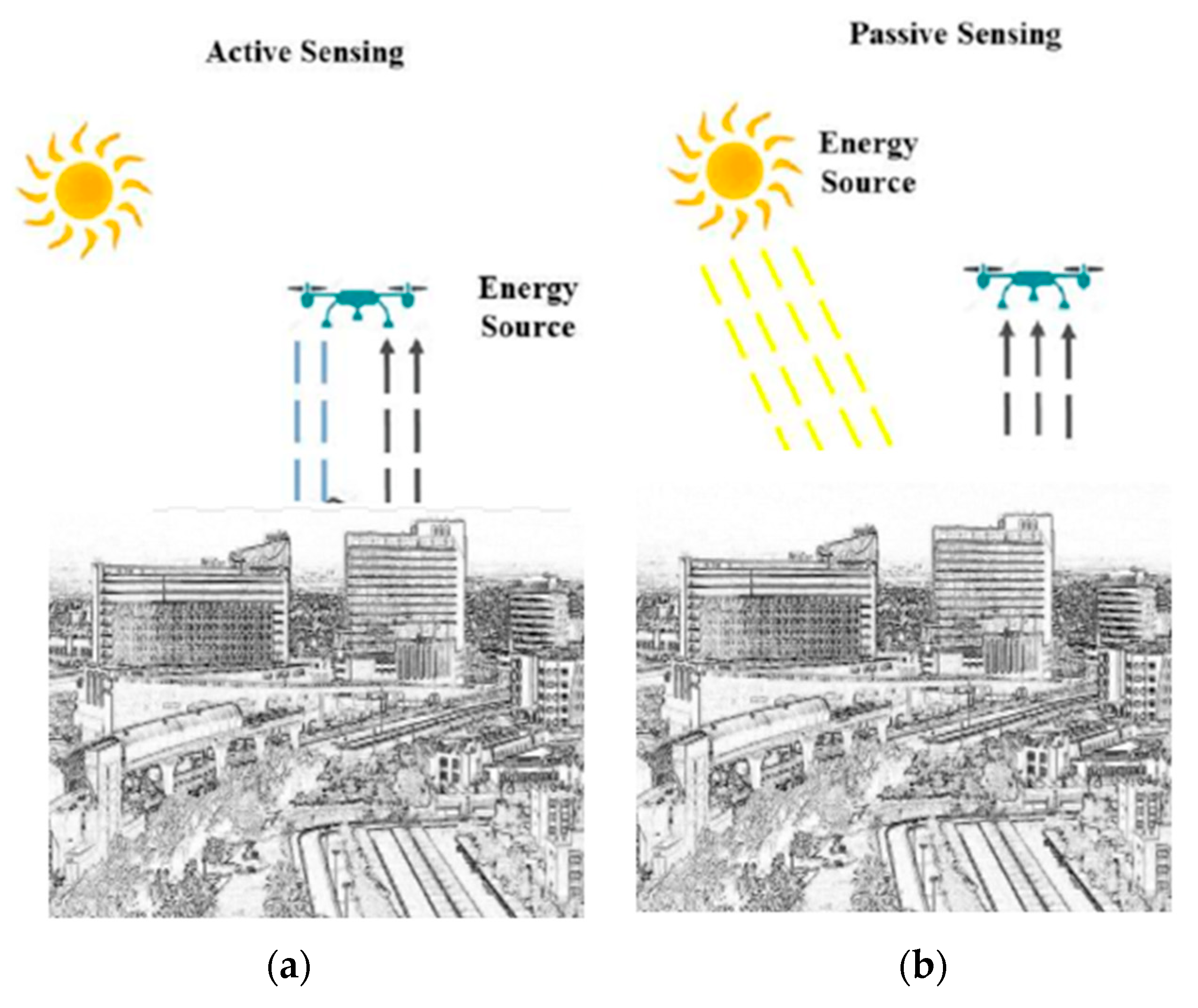

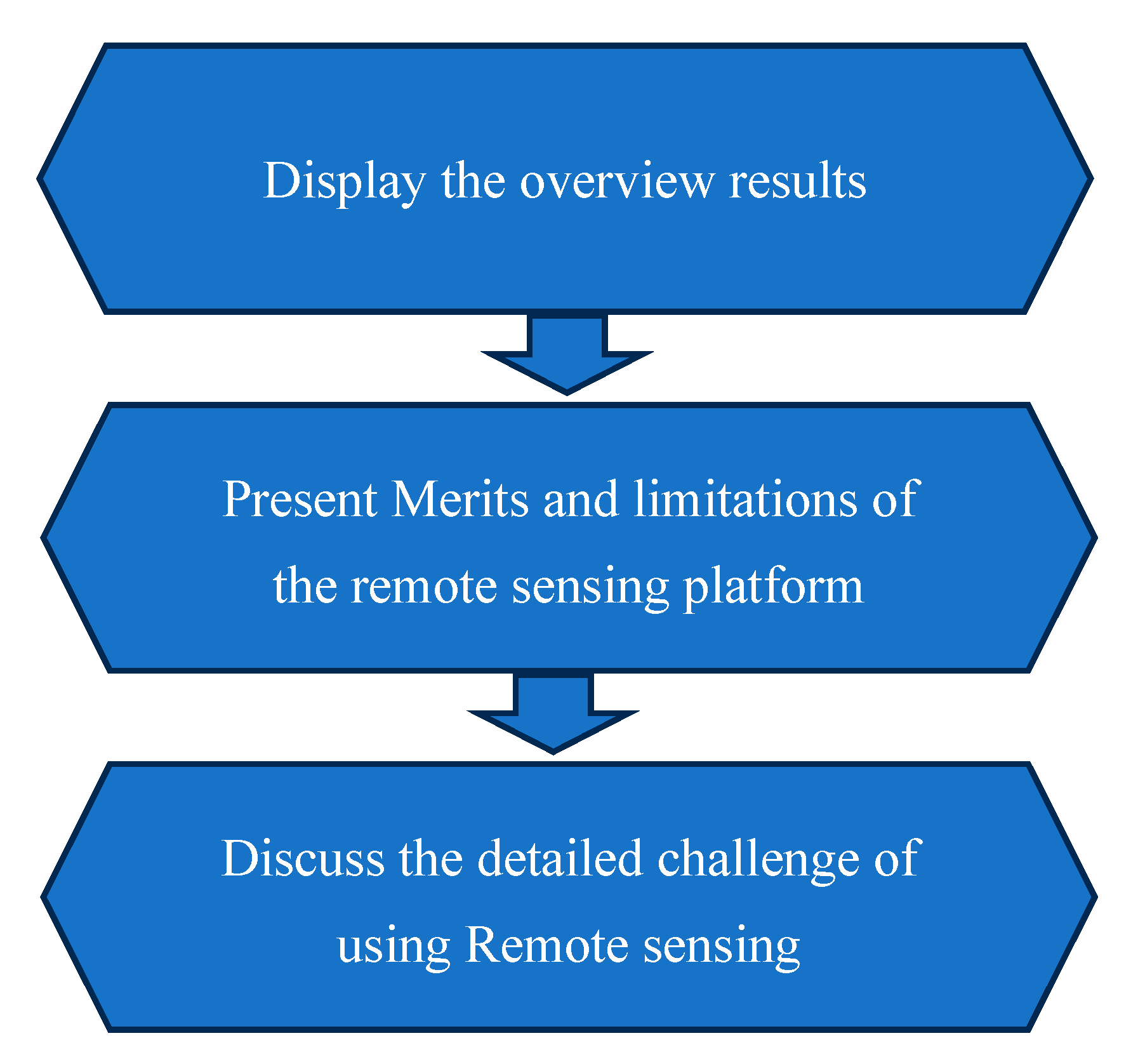

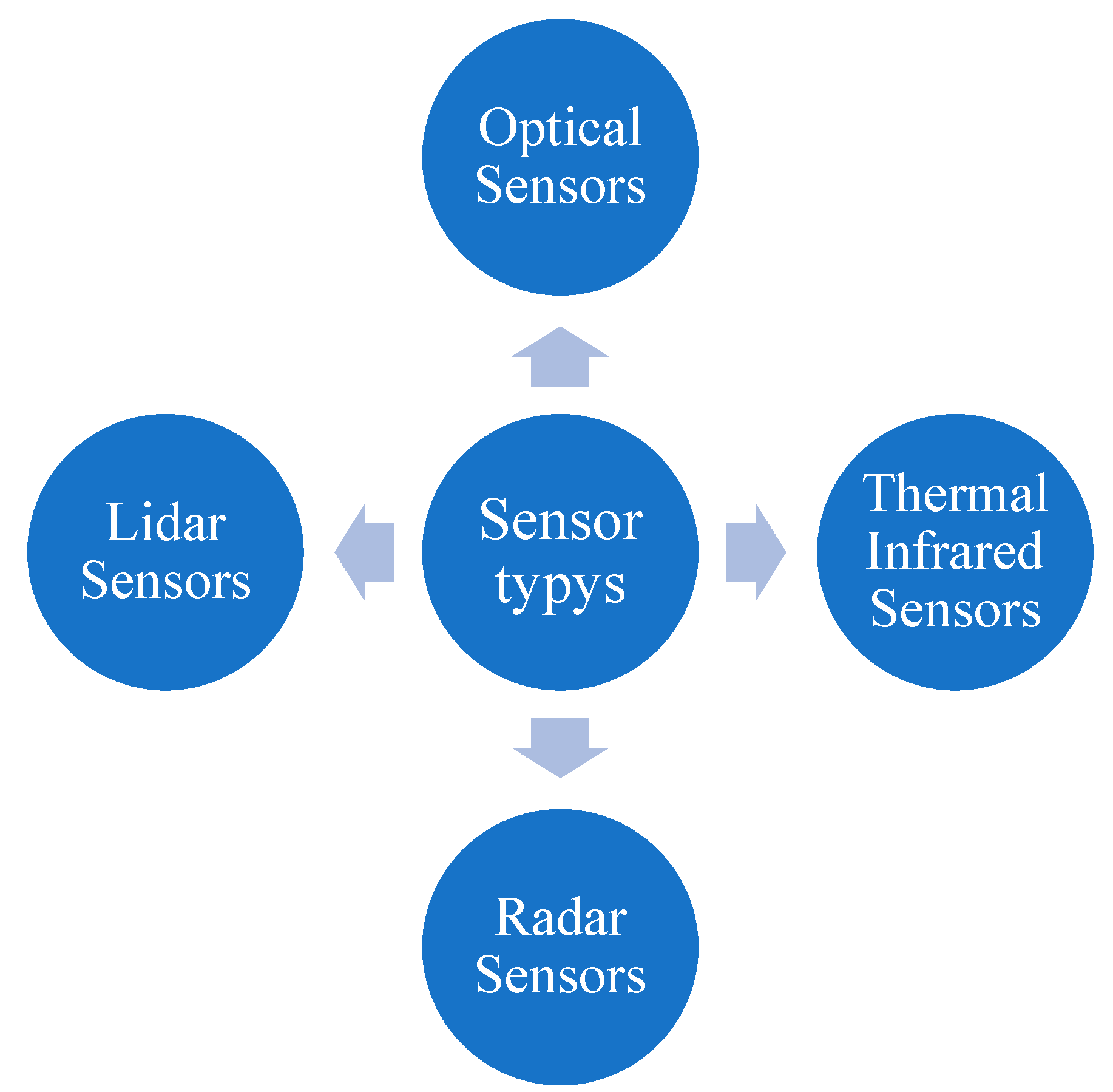
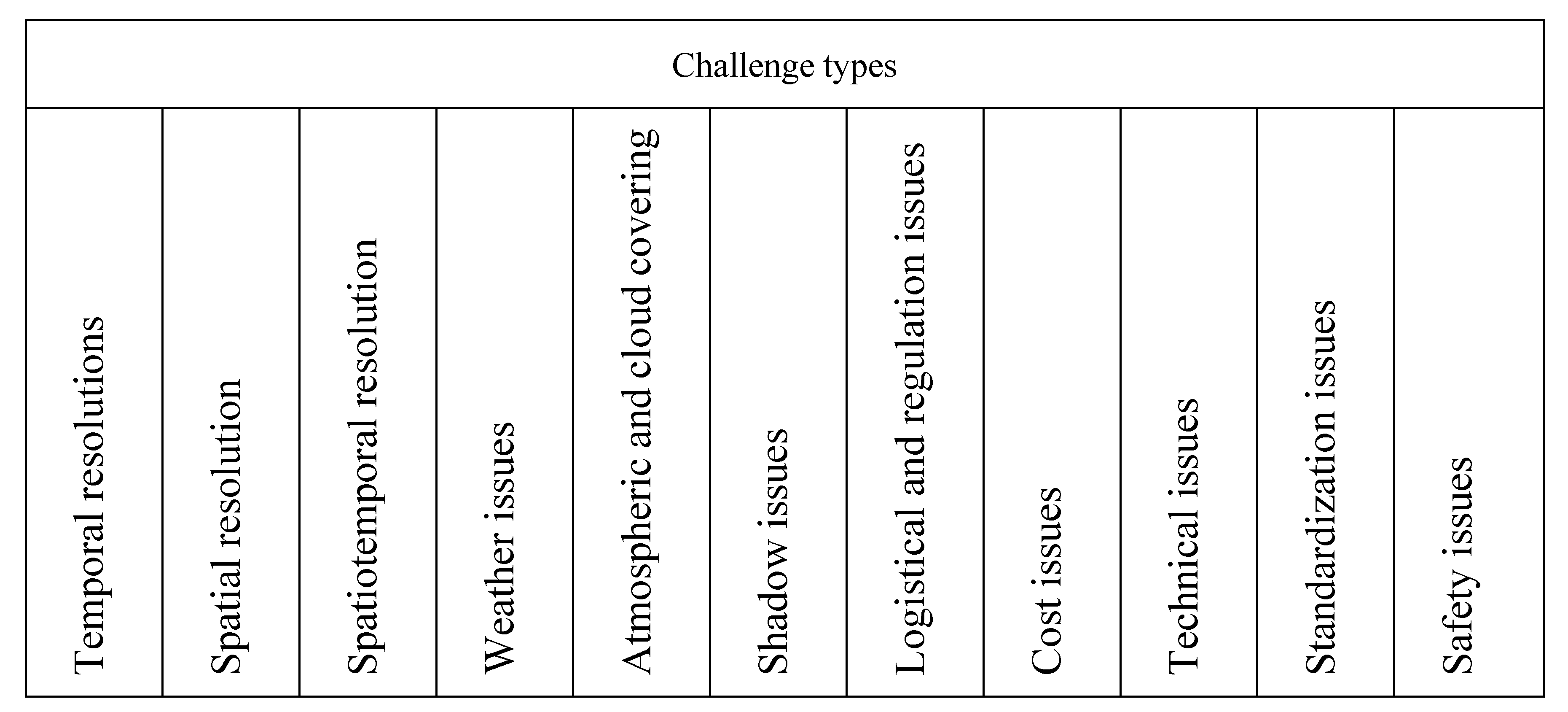
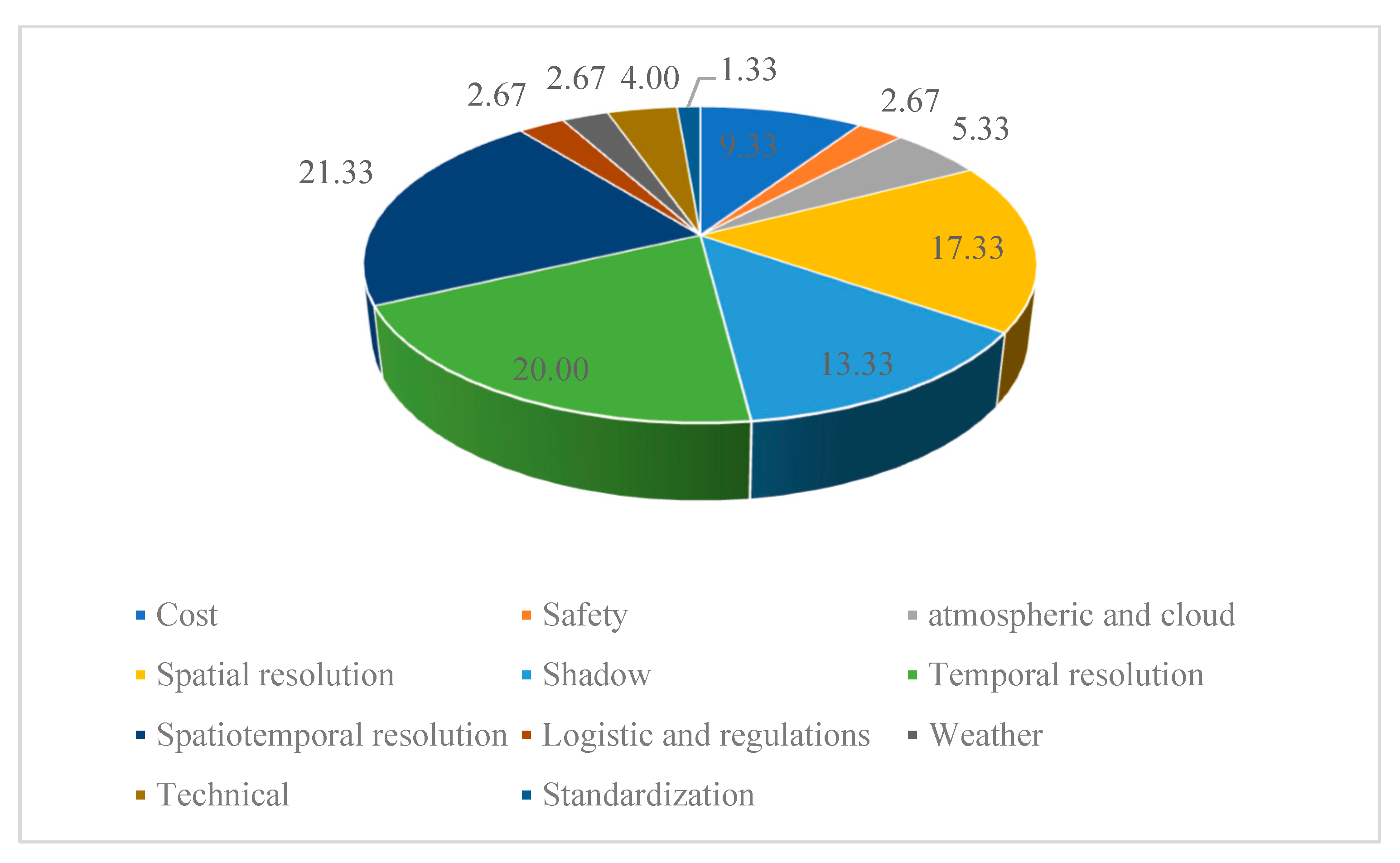
| Name of Journal | Number of Collected Paper |
|---|---|
| Remote sensing | 17 |
| Remote sensing environmental | 12 |
| IEEE | 5 |
| AUG | 3 |
| European journal of remote sensing | 3 |
| International journal of remote sensing | 2 |
| Platform Types | Merits | Limitations | References |
|---|---|---|---|
| Satellite-Based Remote Sensing | Large Coverage Area Regular and Systematic Coverage Multispectral and Hyperspectral Data Long-Term Data Archives Takes images of specific locations on a regular and periodic schedule | Spatial Resolution. Limited Revisit Time Cost and Accessibility Atmospheric Effects | [1,23,24,25,26,27,28,29,30,31,32] |
| Airborne-Based Remote Sensing | High Spatial Resolution Flexibility and On-Demand Deployment Flexibility and On-Demand Deployment Enhanced Data Accuracy | Limited Coverage Area Weather Dependency Higher Operational Costs Restricted Flight Regulations Limits on regularly and periodically taking images of specific locations and user-dependent | [1,25,26,33,34,35,36] |
| Ground-Based Remote Sensing | High Spatial Resolution Real-Time Monitoring Validation and Ground-Truthing Cost-Effectiveness | Limited Coverage Area Labor- and Time-Intensive Accessibility and Permissions Limited Mobility | [37,38,39] |
| Remote Sensor Types | Merits | Limitations | References |
|---|---|---|---|
| Optical Sensors (Visible, Near-Infrared, and Multispectral) |
|
| [40,41,42] |
| Thermal Infrared Sensors |
|
| [43,44,45,46] |
| Radar Sensors (SAR—Synthetic Aperture Radar) |
|
| [47,48,49] |
| Lidar Sensors |
|
| [50,51,52] |
Disclaimer/Publisher’s Note: The statements, opinions and data contained in all publications are solely those of the individual author(s) and contributor(s) and not of MDPI and/or the editor(s). MDPI and/or the editor(s) disclaim responsibility for any injury to people or property resulting from any ideas, methods, instructions or products referred to in the content. |
© 2024 by the author. Licensee MDPI, Basel, Switzerland. This article is an open access article distributed under the terms and conditions of the Creative Commons Attribution (CC BY) license (https://creativecommons.org/licenses/by/4.0/).
Share and Cite
Almohsen, A.S. Challenges Facing the Use of Remote Sensing Technologies in the Construction Industry: A Review. Buildings 2024, 14, 2861. https://doi.org/10.3390/buildings14092861
Almohsen AS. Challenges Facing the Use of Remote Sensing Technologies in the Construction Industry: A Review. Buildings. 2024; 14(9):2861. https://doi.org/10.3390/buildings14092861
Chicago/Turabian StyleAlmohsen, Abdulmohsen S. 2024. "Challenges Facing the Use of Remote Sensing Technologies in the Construction Industry: A Review" Buildings 14, no. 9: 2861. https://doi.org/10.3390/buildings14092861
APA StyleAlmohsen, A. S. (2024). Challenges Facing the Use of Remote Sensing Technologies in the Construction Industry: A Review. Buildings, 14(9), 2861. https://doi.org/10.3390/buildings14092861






